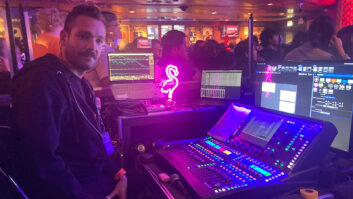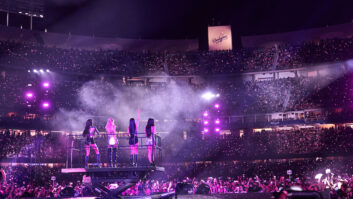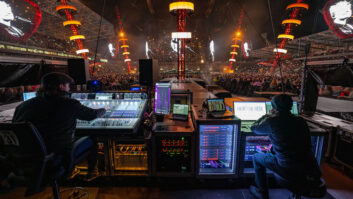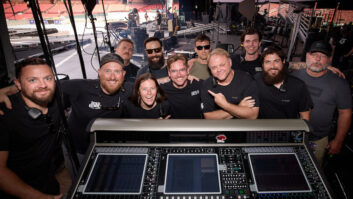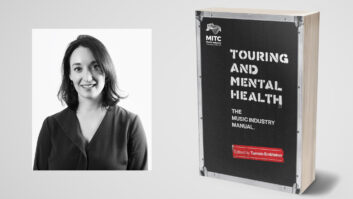In support of their latest release, Zeitgeist, the Smashing Pumpkins’ much-anticipated U.S. tour is drawing the same crowds and attention the band garnered the last time they toured — back in 2000 when the Machina album was at the top of the charts. Today, original bandmembers Billy Corgan (vocals/guitar) and drummer Jimmy Chamberlin are sharing the stage with guitarist Jeff Schroeder, bassist Ginger Reyes and keyboardist Lisa Harriton, booking out select venues for long runs. The tour began in Asheville, N.C., where the current lineup performed a sold-out nine-show residency at the Orange Peel, followed by another sold-out, 11-date gig at San Francisco’s famed Fillmore, where Mix caught up with the tour in mid-July.
When a band sells out an 11-night stay, they’re accorded a certain amount of respect. At the Fillmore, they were allowed to strip the club of its existing gear and install their own system. “Billy really wanted to present a super show, so we negotiated to bring in our own P.A.,” front-of-house engineer Jon Lemon reports. “Nobody’s done that before. In the end, city engineers came in and told us we had to put in new structural beams in the ceiling to create new [hang] points. It’s been pretty interesting.” An L-Acoustics dV-DOSC line array system — 12 per side with four dV-DOSC subs — was flown per side.
And after a one-off show in Santa Cruz (just south of San Francisco) that the band played because the Fillmore had previously booked another act, they placed plywood over the stage decking. “The stage [in Santa Cruz] was wood, and the band has always loved the sound of wood,” says monitor mixer John Shearman. “So we came back in and asked what it was going to take to put wood over the stage. That’s been done, and it’s all for the better. It was tough the first few shows in here — we were having a battle over headroom on the vocals, but it’s all smoothed out now.”
As if remaking a club system wasn’t enough work, Lemon and Shearman got the word that the band was going to work in songs from the Pumpkins’ extensive catalog, as well as tunes that Corgan was coming up with during his stay in San Francisco. As of the middle of July, Lemon reports that he has 74 snapshots stored in his DiGiCo D5 console. “Part of the reason we’re doing these residencies in clubs is that Billy wanted to work in a lot more songs,” Lemon says. And those 74 songs aren’t just sitting in a corner, considering the band is playing sets that run up to three hours and include at least 25 songs. “He changes the set list every night,” Shearman says. “Then there will be two songs that they haven’t done for a couple of weeks and then a new song that he wrote last night.”
NO SLEEP FOR THE WEARY
“We work pretty much every day of the week, whether there’s a show or not,” Lemon says. “We’ll do four hours of rehearsal during the day off, and on a work day we’ll do four hours of rehearsal and three hours of show. It’s almost James Brown-ish in its brutality.” [Laughs] Plus, on the rare days off, Lemon has been heading into local studios to mix the performances for possible live CD or DVD releases. He is recording every show from a MADI split off the DiGiCo D5 console into a Pro Tools HD3 rig for archival purposes. Backstage, another pair of engineers handle two 96k Pro Tools rigs to record the shows for special releases.
Mixing for the band can be challenging for Lemon, but he’s up to the task. The first key to making it happen, the mixer says, is that he doesn’t mix loud, but aims for a sound that’s big and full. The second is having the D5 on hand. “I can change the gains and open up the gates,” he explains. “Without it, I think I’d be sunk. That’s the big difference from when I did this in the mid-’90s and doing it now. I know I have the dynamics well under control.”
In addition to the D5, the tour is carrying an assortment of analog outboard gear at FOH, including a Manley VoxBox, two Smart C2s, an AMS Neve 33609, Summit TLA-100 and a DCL-200, and a Distressor to warm up the sound. Lemon will only add effects during one of the band’s jams. “I’ll pan things around a bit in the background to space things out, especially since we’re here in San Francisco,” he says with a laugh. “I add vocal echoes in the jams, but other than that it’s pretty straight.” Lemon uses a TC Electronic D-Two and System 6000, the D5’s built-in delay and an Eventide Harmonizer “with the ‘Pumpkinizer,’ which is the setting that Billy came up with years ago,” Lemon says. “I use that to give the old songs a different texture.”
The final key to pulling it off, Lemon says, is that he and Corgan agree that live performance is its own entity. “So the song is going to end up where the song is going to end up, because they tweak it around with their arrangements and with the instruments that they use onstage. I have to take that and run with it as the Smashing Pumpkins live sound of 2007,” he says. “It’s just what it is at the end of the day, and it’s usually good because the band plays really tight. I think the sound is far more sophisticated than it used to be.”
Lemon spends extra time on microphone selection to ensure a clean sound. On guitar cabinets, he’ll use Shure 57s and Neumann TLM 103s, which he calls the world’s greatest all-around mics. Chamberlin’s kit gets a Beyer TM88 and a Shure Beta 91 on the kick; the four rack toms are miked with Sennheiser 604 clip-ons; the two floor toms get Neumann TLM 103s; and the main snare sees a Shure Beta 56A and Sennheiser 904 on top with an SM57 underneath. “There are three mics on the snare because Jimmy is such a dynamic player,” Lemon explains. “He’ll rim-shot for half the show and then be back in the center.” A second snare is miked with a 57. As far as cymbals, hi-hats get Neumann 184s and the overheads are TLM 193s.
Because Chamberlin has a full wedge and sub sitting behind him to monitor the show, Lemon has been careful about mic placement. “I’ve got the mics out of the way enough,” he says, “although generally it sounds good through the monitors so I’m not really that worried about it. Any live kit, and I know this from years of doing live CDs and DVDs, is a bit of a jigsaw puzzle, and when you snap it right you’re in.”
The band added a Hammond B3 with a Leslie cabinet, and Lemon miked the top of the cabinet with a pair of Sennheiser 421s and one at the bottom.
Corgan’s vocal mic is a bit unusual, Lemon reports. “It’s a 57A with a 58 ball on it, so it pulls away more from the diaphragm than it would normally be with the 57A. It gives him this mid-high thing that he likes and it cleans up the bottom end a bit.” The backing vocalists are using Neumann KMS 104s.
PUMP UP THE VOLUME
Shearman, who is tucked behind the band against the wall at stage-right, is managing a loud monitor mix. Onstage are four Prism Blues and four Prism subs, two per side, as well as 12 SRM wedges and an ML18 sub for Chamberlin. Keyboardist Harriton is using a Sennheiser ew 300 ear system. “Billy feels that this kind of music needs the air movement that comes with speakers onstage,” Shearman explains. “So we’ve got the big sidefill racks, but there’s not much in it, frankly. It’s mainly kick drum, but it looks rock ‘n’ roll, and maybe that’s part of the reason we’re using them. They are pretty loud because all the bandmembers wear ear plugs.”
Strangely, that bit of news takes Lemon by surprise. “Does Billy? I didn’t know that.”
“Yeah, he wears the yellow ones cut in half so you can’t really see them,” Shearman answers with a laugh. “He’s always worn them, but he has the amazing ability that if you change something, he’ll look over straightaway. He’s got super-hearing.”
One of the things that make the wedge mixes a little more palatable for both Lemon and Shearman is the fact that the band manages their backline mixes and can hear each other without monitors. “The wedges are there to emphasize what they can’t hear,” he explains. “So all Billy has in his wedges are vocals. Ginger has a little bass in there from time to time, and Jeff has a little guitar, as well. The drum mix is the one mix that changes from song to song and that’s like a full-on front-of-house mix, basically. That’s the main one I mix for the whole show.”
After the Fillmore residency concluded August 1, the band was set to return to Europe for 10 headlining and festival shows, where Lemon and Shearman will face whatever new challenges arise from this evolved version of Smashing Pumpkins. “There’s so much more texture now,” Lemon says. “There’s no doubt that all of them are better players and the new ones are great players. It’s a natural progression and it’s quite good.”
David John Farinella is a San Francisco-based writer.



